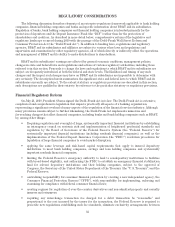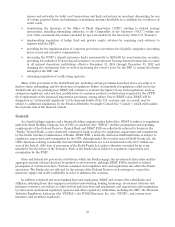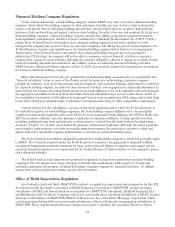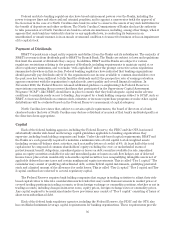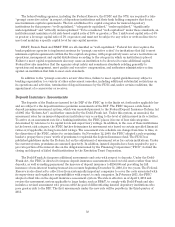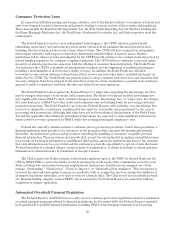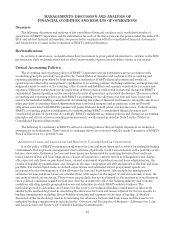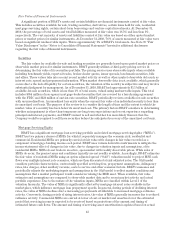BB&T 2010 Annual Report Download - page 34
Download and view the complete annual report
Please find page 34 of the 2010 BB&T annual report below. You can navigate through the pages in the report by either clicking on the pages listed below, or by using the keyword search tool below to find specific information within the annual report.Financial Holding Company Regulation
Under current federal law, a bank holding company, such as BB&T, may elect to become a financial holding
company, which allows the holding company to offer customers virtually any type of service that is financial in
nature or incidental thereto, including banking and activities closely related thereto, securities underwriting,
insurance (both underwriting and agency) and merchant banking. In order to become and maintain its status as a
financial holding company, a financial holding company and all of its affiliated depository institutions must be
well-capitalized, well-managed, and have at least a satisfactory Community Reinvestment Act of 1977 (“CRA”)
rating. If the Federal Reserve determines that a financial holding company is not well-capitalized or well-
managed, the company has a period of time to come into compliance, but during the period of noncompliance, the
Federal Reserve can place any limitations on the financial holding company that it believes to be appropriate.
Furthermore, if the Federal Reserve determines that a financial holding company has not maintained a
satisfactory CRA rating, the company will not be able to commence any new financial activities or acquire a
company that engages in such activities, although the company will still be allowed to engage in activities closely
related to banking and make investments in the ordinary course of conducting merchant banking activities.
BB&T became a financial holding company on June 14, 2000, and currently satisfies the requirements to maintain
its status as a financial holding company.
Most of the financial activities that are permissible for financial holding companies also are permissible for a
“financial subsidiary” of one or more of the Banks, except for insurance underwriting, insurance company
portfolio investments, real estate investments and development, and merchant banking, which must be conducted
in a financial holding company. In order for these financial activities to be engaged in by a financial subsidiary of a
bank, federal law requires the parent bank (and its sister-bank affiliates) to be well-capitalized and well-managed;
the aggregate consolidated assets of all of that bank’s financial subsidiaries may not exceed the lesser of 45% of
its consolidated total assets or $50 billion; the bank must have at least a satisfactory CRA rating; and, if that bank
is one of the 100 largest national banks, it must meet certain financial rating or other comparable requirements.
Current federal law also establishes a system of functional regulation under which the Federal Reserve is
the umbrella regulator for bank holding companies, but bank holding company affiliates are to be principally
regulated by functional regulators such as the FDIC for state nonmember bank affiliates, the OTS for thrifts, the
SEC for securities affiliates and state insurance regulators for insurance affiliates. Certain specific activities,
including traditional bank trust and fiduciary activities may be conducted in the bank without the bank being
deemed a “broker” or a “dealer” in securities for purposes of functional regulation. Although the states generally
must regulate bank insurance activities in a nondiscriminatory manner, the states may continue to adopt and
enforce rules that specifically regulate bank insurance activities in certain identifiable areas.
The Dodd-Frank Act establishes additional regulation for bank holding companies, which will generally apply
to BB&T. The Council is required under the Dodd-Frank Act to monitor emerging risks to financial stability,
recommend heightened prudential standards for large, interconnected financial companies and require certain
non-bank financial companies to be supervised by the Federal Reserve if their activities are determined to pose a
risk to financial stability.
The Dodd-Frank Act also imposes new prudential regulation on depository institutions and their holding
companies. The law imposes new, more stringent standards and requirements with respect to (1) bank and
nonbank acquisitions and mergers, (2) financial holding companies engaged in “financial activities,” (3) affiliate
transactions and (4) proprietary trading, among other provisions.
Office of Thrift Supervision Regulation
As a federally chartered thrift, BB&T FSB is subject to regulation, supervision and examination by the OTS.
In connection with the charter conversion of BB&T Bankcard Corporation to BB&T FSB, certain operating
subsidiaries of BB&T and Branch Bank were transferred to BB&T FSB. Specifically, Sheffield Financial, LLC
and MidAmerica Gift Certificate Company, which were previously direct operating subsidiaries of BB&T, became
divisions or subsidiaries of BB&T FSB. BB&T Credit Services, Inc. and Liberty Mortgage Corporation (which
ceased operations during 2010) were previously subsidiaries of Branch Bank and reorganized as subsidiaries of
BB&T FSB. These organizational structure changes were made to optimize the operating efficiency of these
34










